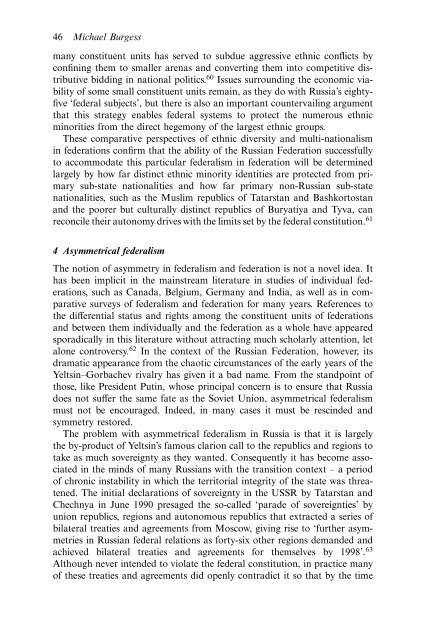Federalism and Local Politics in Russia
Federalism and Local Politics in Russia
Federalism and Local Politics in Russia
Create successful ePaper yourself
Turn your PDF publications into a flip-book with our unique Google optimized e-Paper software.
46 Michael Burgessmany constituent units has served to subdue aggressive ethnic conflicts byconf<strong>in</strong><strong>in</strong>g them to smaller arenas <strong>and</strong> convert<strong>in</strong>g them <strong>in</strong>to competitive distributivebidd<strong>in</strong>g <strong>in</strong> national politics. 60 Issues surround<strong>in</strong>g the economic viabilityof some small constituent units rema<strong>in</strong>, as they do with <strong>Russia</strong>’s eightyfive‘federal subjects’, but there is also an important countervail<strong>in</strong>g argumentthat this strategy enables federal systems to protect the numerous ethnicm<strong>in</strong>orities from the direct hegemony of the largest ethnic groups.These comparative perspectives of ethnic diversity <strong>and</strong> multi-nationalism<strong>in</strong> federations confirm that the ability of the <strong>Russia</strong>n Federation successfullyto accommodate this particular federalism <strong>in</strong> federation will be determ<strong>in</strong>edlargely by how far dist<strong>in</strong>ct ethnic m<strong>in</strong>ority identities are protected from primarysub-state nationalities <strong>and</strong> how far primary non-<strong>Russia</strong>n sub-statenationalities, such as the Muslim republics of Tatarstan <strong>and</strong> Bashkortostan<strong>and</strong> the poorer but culturally dist<strong>in</strong>ct republics of Buryatiya <strong>and</strong> Tyva, canreconcile their autonomy drives with the limits set by the federal constitution. 614 Asymmetrical federalismThe notion of asymmetry <strong>in</strong> federalism <strong>and</strong> federation is not a novel idea. Ithas been implicit <strong>in</strong> the ma<strong>in</strong>stream literature <strong>in</strong> studies of <strong>in</strong>dividual federations,such as Canada, Belgium, Germany <strong>and</strong> India, as well as <strong>in</strong> comparativesurveys of federalism <strong>and</strong> federation for many years. References tothe differential status <strong>and</strong> rights among the constituent units of federations<strong>and</strong> between them <strong>in</strong>dividually <strong>and</strong> the federation as a whole have appearedsporadically <strong>in</strong> this literature without attract<strong>in</strong>g much scholarly attention, letalone controversy. 62 In the context of the <strong>Russia</strong>n Federation, however, itsdramatic appearance from the chaotic circumstances of the early years of theYelts<strong>in</strong>–Gorbachev rivalry has given it a bad name. From the st<strong>and</strong>po<strong>in</strong>t ofthose, like President Put<strong>in</strong>, whose pr<strong>in</strong>cipal concern is to ensure that <strong>Russia</strong>does not suffer the same fate as the Soviet Union, asymmetrical federalismmust not be encouraged. Indeed, <strong>in</strong> many cases it must be resc<strong>in</strong>ded <strong>and</strong>symmetry restored.The problem with asymmetrical federalism <strong>in</strong> <strong>Russia</strong> is that it is largelythe by-product of Yelts<strong>in</strong>’s famous clarion call to the republics <strong>and</strong> regions totake as much sovereignty as they wanted. Consequently it has become associated<strong>in</strong> the m<strong>in</strong>ds of many <strong>Russia</strong>ns with the transition context – a periodof chronic <strong>in</strong>stability <strong>in</strong> which the territorial <strong>in</strong>tegrity of the state was threatened.The <strong>in</strong>itial declarations of sovereignty <strong>in</strong> the USSR by Tatarstan <strong>and</strong>Chechnya <strong>in</strong> June 1990 presaged the so-called ‘parade of sovereignties’ byunion republics, regions <strong>and</strong> autonomous republics that extracted a series ofbilateral treaties <strong>and</strong> agreements from Moscow, giv<strong>in</strong>g rise to ‘further asymmetries<strong>in</strong> <strong>Russia</strong>n federal relations as forty-six other regions dem<strong>and</strong>ed <strong>and</strong>achieved bilateral treaties <strong>and</strong> agreements for themselves by 1998’. 63Although never <strong>in</strong>tended to violate the federal constitution, <strong>in</strong> practice manyof these treaties <strong>and</strong> agreements did openly contradict it so that by the time
















